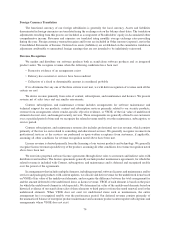Symantec 2007 Annual Report Download - page 84
Download and view the complete annual report
Please find page 84 of the 2007 Symantec annual report below. You can navigate through the pages in the report by either clicking on the pages listed below, or by using the keyword search tool below to find specific information within the annual report.We are required to compute our income taxes in each federal, state, and international jurisdiction in which we
operate. This process requires that we estimate the current tax exposure as well as assess temporary differences
between the accounting and tax treatment of assets and liabilities, including items such as accruals and allowances
not currently deductible for tax purposes. The income tax effects of the differences we identify are classified as
current or long-term deferred tax assets and liabilities in our Consolidated Balance Sheets. Our judgments,
assumptions, and estimates relative to the current provision for income tax take into account current tax laws, our
interpretation of current tax laws, and possible outcomes of current and future audits conducted by foreign and
domestic tax authorities. Changes in tax laws or our interpretation of tax laws and the resolution of current and
future tax audits could significantly impact the amounts provided for income taxes in our Consolidated Balance
Sheets and Consolidated Statements of Income. We must also assess the likelihood that deferred tax assets will be
realized from future taxable income and, based on this assessment, establish a valuation allowance, if required. Our
determination of our valuation allowance is based upon a number of assumptions, judgments, and estimates,
including forecasted earnings, future taxable income, and the relative proportions of revenue and income before
taxes in the various domestic and international jurisdictions in which we operate. The valuation allowance provided
significantly relates to acquired attributes and therefore any future benefit of the realization of the deferred tax
assets subject to this valuation allowance will be credited to goodwill. To the extent we establish a valuation
allowance or change the valuation allowance in a future period, we reflect the change with a corresponding increase
or decrease to our tax provision in our Consolidated Statements of Income, or to goodwill to the extent that the
valuation allowance related to tax attributes of the acquired entities.
Net Income Per Share
Net income per share — basic and diluted are presented in conformity with SFAS No. 128, Earnings per
Share, for all periods presented. Net income per share — basic is computed using the weighted-average number of
common shares outstanding during the periods. Net income per share — diluted is computed using the weighted-
average number of common shares outstanding and potentially dilutive common shares outstanding during the
periods. Potentially dilutive common shares include the assumed exercise of stock options using the treasury stock
method, the dilutive impact of restricted stock, restricted stock units, and warrants using the treasury stock method,
and conversion of debt, if dilutive in the period. Potentially dilutive common shares are excluded in net loss periods,
as their effect would be antidilutive.
Stock-Based Compensation
Prior to April 1, 2006, we accounted for stock-based compensation awards to employees using the intrinsic
value method in accordance with Accounting Principles Board Opinion, or APB, No. 25, Accounting for Stock
Issued to Employees, and to non-employees using the fair value method in accordance with SFAS No. 123,
Accounting for Stock-Based Compensation. In addition, we applied applicable provisions of FIN 44, Accounting for
Certain Transactions Involving Stock Compensation, an interpretation of APB No. 25.
Effective April 1, 2006, we adopted the provisions of SFAS No. 123R, Share-Based Payment, which replaced
SFAS No. 123 and superseded APB No. 25 and related interpretations. Under SFAS No. 123R, we must measure the
fair value of all stock-based awards, including stock options, restricted stock units, and employee stock purchase
plan purchase rights, on the date of grant and amortize the fair value of the award to compensation expense over the
requisite service period. We elected the modified prospective application method, under which prior periods are not
revised for comparative purposes. The valuation provisions of SFAS No. 123R apply to new awards and to awards
outstanding as of the effective date that are subsequently modified. For stock-based awards granted on or after
April 1, 2006, we recognize stock-based compensation expense on a straight-line basis over the requisite service
period, which is generally the vesting period. We recognize estimated compensation expense for stock-based
awards that were outstanding and unvested as of the effective date on a straight-line basis over the remaining service
period under the pro forma provisions of SFAS No. 123.
As a result of adopting SFAS No. 123R, our Net income per share — basic and Net income per share —
diluted are each $0.12 lower in fiscal 2007 than if we had continued to account for stock-based compensation under
APB No. 25.
78
























